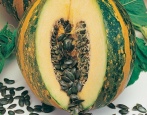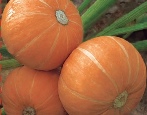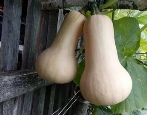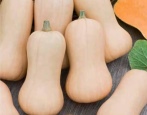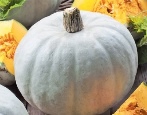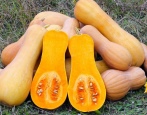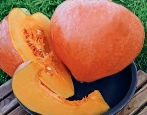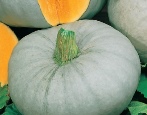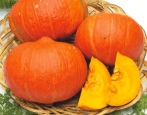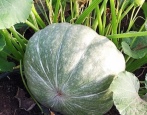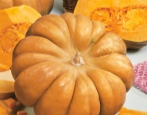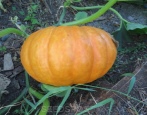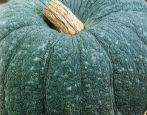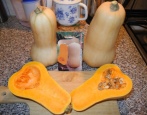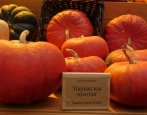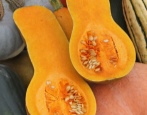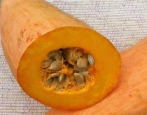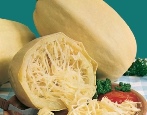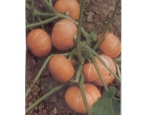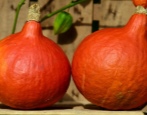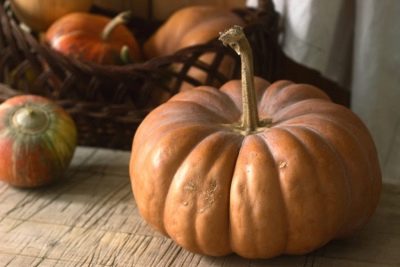
- Name synonyms: Musquee De Provence
- Year of approval: 2013
- Growth type: medium power
- Leaf color: green, no white spot
- The form: flat-round
- Weight, kg: 3-8
- Coloration: orange-brown
- Bark: thin
- Color of the pulp: orange
- Pulp thickness, cm: 8-10
Among all the variety of pumpkin melons and gourds, the most popular are muscat species, including Muscat Provence (Muscat de Provence), synonymous with Musquee De Provence. The peculiarities of the melons and gourds of this type are in the aroma and dessert taste, thin skin and high sugar content (up to 15%).
Breeding history
The homeland of the variety is France, where the concept of "Muscat" has the magic of aroma and delicate taste. The variety was registered in the State Register of Breeding Achievements of the Russian Federation in 2013.
Description of the variety
The Muscat Provencal variety has aromatic fruits with an exquisite taste. The melon crop, which owes its appearance to hot Mexico, turned out to be as popular as potatoes, maize, and tomatoes. Having mastered all the continents, she took root in our country. Provencal nutmeg contains many nutrients, vitamins, macro- and microelements.
It is recommended for people with gastrointestinal diseases due to the presence of cellulose and organic acids. In addition, the plant itself has an attractive appearance, especially when the pumpkins reach technical ripeness and burn with Chinese lanterns against the backdrop of greenery. During flowering, pumpkin attracts many bees and bumblebees through its powerful pollen production.
Characteristics of the appearance of plants and fruits
The medium-growing variety has a growth of medium strength, the length of rough and hooked whips reaches 3-4 meters. Segmented flat-round fruits are quite impressive in size - from 3 to 8 kilograms. The thin bark has a slightly ribbed texture. Rounded flattened fruits are colored brownish-orange with a gray undertone.
The pulp has almost the same shades, only more saturated. The thickness of the dense mid-term pulp is from 8 to 10 cm. Loose planets contain medium-sized seed nests filled with a large number of medium-sized cream-colored seeds. It contains more than 6% dry matter and a high content of carotene. Fruits are capable of long-term storage provided the necessary conditions are met.
Purpose and taste
Fruits of universal purpose are used in cooking to create desserts, candied fruits, preparation of first and second courses, cooking juices and preserves, jams and confitures. Use Provencal Nutmeg in baby food and dietary formulas. The fruits are characterized as sweet, with excellent taste.
Ripening terms
The variety belongs to the mid-late category - from germination to harvesting takes from 110 to 115 days.
Yield
Yield indicators of Muscat Provencal are considered high: on average, 2.8-4.3 kilograms are harvested from 1 square meter, but these are not the maximum figures. Under ideal conditions, the variety is capable of more.
Growing regions
The pumpkin born in France has been adapted in Russia in almost all regions. These are the North, North-West, Central, Volgo-Vyatka, TsChO, North Caucasian regions, as well as the Middle Volga, Lower Volga, Ural, West Siberian, East Siberian and Far Eastern regions.
Growing and care
The variety is highly resistant to drought, grows well on loose and breathable fertile soils with a neutral pH level, rich in humus and organic matter (humus, manure, compost, bird droppings). The southern culture does not develop well in shaded cold areas, does not like predecessors such as:
- cucumbers;
- zucchini;
- squash.
Ideal previous landings are:
- onion and garlic;
- peas, beans and beans;
- potatoes, beets and carrots.
The site should be protected from cold winds and marshy lowlands. In cold regions, it is most correct to grow the nutmeg species in seedlings under cover, in greenhouses.
Seeds are sown for seedlings in April or early May; they are planted in open ground after the threat of recurrent frosts has passed. In the southern regions, the dates are shifted closer to early spring. The optimal planting scheme is 70x70 cm. Seeds are immersed to a depth of 5-10 cm in open ground and 3-5 cm during sowing in containers for seedlings.
Further care of the culture consists of standard techniques. Watering should be carried out on a regular basis until about mid-summer, then they are reduced and soon stopped completely. Before ripening, pumpkin needs a lot of moisture: about 20 liters per square meter.
Loosening provides oxygen access and destroys the fine hairy roots of the weeds. Weeding will help rid the pumpkin of competing nutrients. However, these works are carried out until the foliage is closed by a continuous carpet. After that, it is impossible to loosen or weed, otherwise it is really impossible to damage the whips and flowers.
The soil well filled with fertilizers and organic matter during the preparation of the site relieves the gardener from the need for fertilizing. However, if there are not enough nutrients, the development of the plant slows down, which subsequently negatively affects the quality and quantity of the crop. The first feeding with ammonium nitrate is carried out 10-15 days after planting. Then the pumpkin will need nitrogen-potassium fertilizers. Infusions of mullein or chicken manure are considered good fertilizers.
Even unripe pumpkins can be harvested in the fall. They will perfectly get to the condition during the laying process. When collecting fruits, the stalk is left at least 10 centimeters long. This technique provides longer storage. Pumpkins can be stored at room temperature, but vegetable storage mode suits them better. Ideal conditions are 8-10ºC, no high humidity and ventilation system. In such a room, the fruits can be preserved without damage until spring.
Disease and pest resistance
The variety has strong immunity that protects it from most diseases, including powdery mildew, but this does not mean that it is invulnerable to them. Almost all types of pumpkin are characterized as resistant, but preventive measures remain the best guarantee of maintaining the health and development of the plant: treatment with insecticides and fungicides.
The most common problems are as follows.
- Spider mites sometimes become a scourge for melons and gourds. Overlook and delay in confronting an aggressor can lead to a complete loss of crops. In the fight against the pest, acaricides are used. Traditional methods are an infusion of onions or garlic, but they noticeably lose their effectiveness, because the parasites mutate and adapt.
- The melon aphid can grow in weedy areas. The best remedy for pest control is insecticides.
- Bacteriosis manifests itself in the form of brown spots on the surface of the leaf plate and ulcers on the pumpkins themselves. Bordeaux liquid in a 1% solution comes to the rescue. When treating the affected areas, healthy neighboring ones should not be left without spraying.
- Root and white rot are fungal diseases and appear in high humidity conditions. Use a solution of copper sulfate, reduce the amount of watering.
